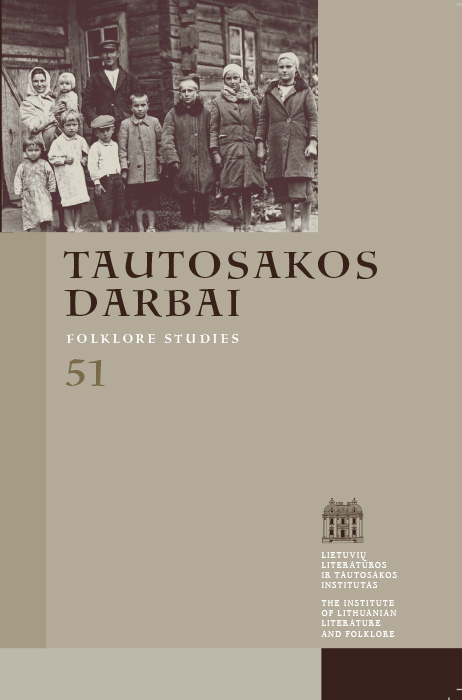Mead in the Baltic Society: from Beekeepers to Nobility
Abstract
Although the living tradition of making mead and partaking of it has become extinct in Latvia and Lithuania in the course of the recent centuries, its traces can still be found in the historical, ethnographic and folklore sources. This tradition is particularly prominent in two cases: in the nobility feasts of the 15th–16th centuries and in the parties held by beekeepers in the 19th–20th centuries.
Mead used to play a significant social and political role in the life of nobility in the Grand Duchy of Lithuania: not only the ruler and the court, but also foreign leaders and diplomats arriving to make political and commercial contracts enjoyed it. The mead consumption indicated the social prestige of the nobles. Although following Christianization of Lithuania, wine grew increasingly frequent in the nobility’s feasts, mead nevertheless preserved its firm position until the 16th century; even until the 17th century, it was still popular among the nobles.
Because of its social and political importance in the nobility’s life, mead also entered the legendary tradition. The 16th century Renaissance historians (Erasmus Stella, Simon Grunau, Lucas David and others) describing the origins of the Prussians and Lithuanians, depict mead as the drink of the noble warriors. According to the legends, mead was an invention and the favored drink of the Cymbrian (Gotland) nobles arriving to Prussia and subsequently sharing it with the local Prussian nobility, thus legitimizing its equal status. The legendary Prussian king Widewuto established his Prussian kingdom following the pattern of the beehive and grouping the members of the society according to their occupation (fieldworkers, beekeepers, stockbreeders, etc.) To ensure the lasting peace in his kingdom, Widewuto introduced the public mead-drinking feasts. However, not only the nobility, but also the commoners enjoyed drinking mead. Since procuring its main ingredient – honey – depends on the activity of the beekeepers, the author devotes special attention to their life style, social communication and festivities.
Until the 16th century, the hollow-tree beehives in the woods were much more common in Lithuania than the artificial ones kept in the homesteads; therefore, the trade of procuring honey had much in common with hunting, since both activities took place in the forest. Because of the wild nature and unpredictable behavior of bees, the beekeepers much as the hunters depended on luck and the deities in charge of good fortune, differing in this respect from husbandmen. On the other hand, beekeeping in the Baltic lands was more than just part of economy: it was a social phenomenon, binding the beekeepers together as friends. The beekeepers believed that keeping the bees single-handedly caused bad luck; therefore, one had to share both the beekeeping tasks and the procured honey with one or several partners in trade. The friendship ties established by the beekeepers united them into beekeeping communities (bičiuolija), the members of which tended to the bees together and at least twice a year (during the honey harvesting and in spring, when tending to the tree-hollows) arranged parties for their members (literally – friends, bičiuliai in Lithuanian). During these parties, the beekeepers and their families enjoyed eating and offering honey and drinking mead together. These parties of beekeepers provided an alternative to those held by husbandmen, called sambariai, during which the whole village community drank beer made of the grain collected from all the farms.
The phenomenon of bičiulystė (literally, friendship by means of beekeeping) is characteristic exclusively to the Balts, therefore it must have formed as early as the Baltic tribal period. In the 12th – the beginning of the 13th century, when the process of political integration gained momentum, the political leadership formed in the Baltic tribes, and the military nobility emerged. It is quite likely, that the social pattern of bičiulystė was rather handy in this process. The communities of beekeepers, binding inhabitants of different villages by mutual trust, loyalty and cooperation, provided an ideal media to form the soldiery, i.e. friends in arms (amicia). The masculine character of these communities, their association with hunting and rituals of good fortune, the reinforcement of mutual connections by means of marriage, and the mead-drinking parties may serve as additional arguments in favor of this assumption.
The analysis allows us assuming that mead-drinking festivities arranged in Lithuania by members of different social layers have common roots in the ancient communities of beekeepers characteristic to the Balts. In the process of social differentiation and stratification, the social pattern of bičiulystė found different use among the nobles and the peasants. Among the nobles, the mead-drinking feasts disappeared in the 17th century, while beekeeping peasants arranged their parties until the beginning of the 20th century.
Downloads
Most read articles by the same author(s)
- Daiva Vaitkevičienė, Charming and Praying: the Soft Power in the Lithuanian Charms , Tautosakos darbai: Vol. 64 (2022)
- Daiva Vaitkevičienė, “Užkalbėjimas”, “žadėjimas”, “vardijimas”: Outlining the Emic Terminology , Tautosakos darbai: Vol. 67 (2024): Tautosakos darbai
- Austė Nakienė, Daiva Vaitkevičienė, Vita Džekčioriūtė-Medeišienė, Gražina Kadžytė, Aurimas Bačiulis, Vida Savoniakaitė, Lina Būgienė, Chronicle , Tautosakos darbai: Vol. 55 (2018)
- Daiva Vaitkevičienė , At the Roots of the Tree of Life: Marija Gimbutas among the Family Women , Tautosakos darbai: Vol. 62 (2021)
- Daiva Vaitkevičienė, Following the Pathways of Greimas’ Mythology , Tautosakos darbai: Vol. 53 (2017)
- Daiva Vaitkevičienė, Rolandas Petkevičius as Researcher of Lithuanian Ethnopsychiatry , Tautosakos darbai: Vol. 54 (2017)
- Daiva Vaitkevičienė, The Sacred Coexistence: Wild Animals in the Peasant Homestead , Tautosakos darbai: Vol. 56 (2018)
- Daiva Vaitkevičienė, Dainius Razauskas, Researching Mythology – with the Heart and from the Heart. Daiva Vaitkevičienė interviewing Dainius Razauskas , Tautosakos darbai: Vol. 60 (2020)
- Daiva Vaitkevičienė, A Book about a Unique Collection of Latvian Charms , Tautosakos darbai: Vol. 61 (2021)
- Daiva Vaitkevičienė, Foreword , Tautosakos darbai: Vol. 62 (2021)
